Constant Contact review 2026: Is it worth your money?
 Miglė, Head of Product at MailerLite
Miglė, Head of Product at MailerLite
Constant Contact has been a leading email marketing software for a long time and for good reasons. This email marketing platform is known for its ease of use and for being beginner-friendly.
Starting from its step-by-step onboarding to its intuitive email editor and its massive set of integrations—Constant Contact shines for many reasons.
But when you look deeper into its features, is it as comprehensive as other popular email marketing providers on the market? Does it let you scale your newsletter or business without making a serious dent in your budget? Let’s find out.
Introducing Constant Contact email campaigns
"Love at first sight"—this is what you might feel when you first "meet" Constant Contact, especially if you're new to email marketing. From one of the smoothest and most helpful onboarding processes to the ease with which you can create multichannel campaigns, Constant Contact will make you fall in love.
But while the platform is super beginner-friendly, starting at $12 per month with basic email marketing, social media marketing, and a host of integrated apps, the cost quickly adds up if you want features like advanced automation or A/B testing.
You’ll also start noticing some limitations as you dig deeper. For example, automation and segmentation options are restricted, the templates look less modern compared to others, and the pricing increases faster than some alternatives. Plus, user discussions on communities like Reddit often mention concerns about pricing transparency.
But we're getting ahead of ourselves. Let's start at the beginning.
Getting started with signup and onboarding
"Smooth as butter" onboarding? That's Constant Contact. It immediately stands out by asking relevant questions to tailor your experience. Want to attract new customers, promote a product, run events, or collect donations? The tool customizes the rest of the onboarding based on your answers.
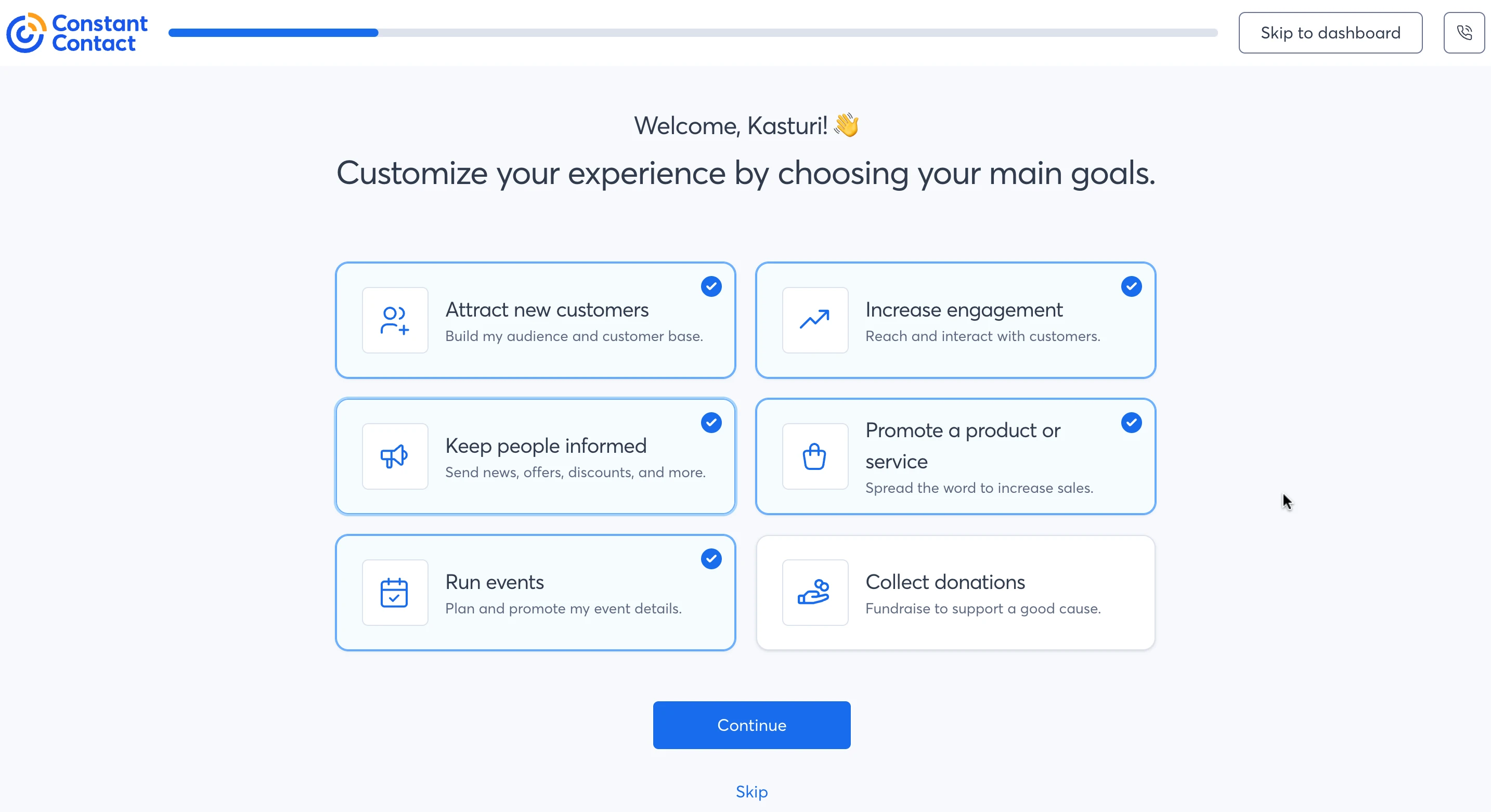
It even asks about your preferred features—email marketing, social media marketing, automations, ads—and whether you have a website, email list, social media presence, or CRM.
Once set, I landed on a dashboard that was extremely intuitive, guiding me to my next steps.

A standout feature is how it pulled my brand colors from my website to automatically create marketing asset templates. For beginners or small business owners, this personalized touch is very thoughtful.
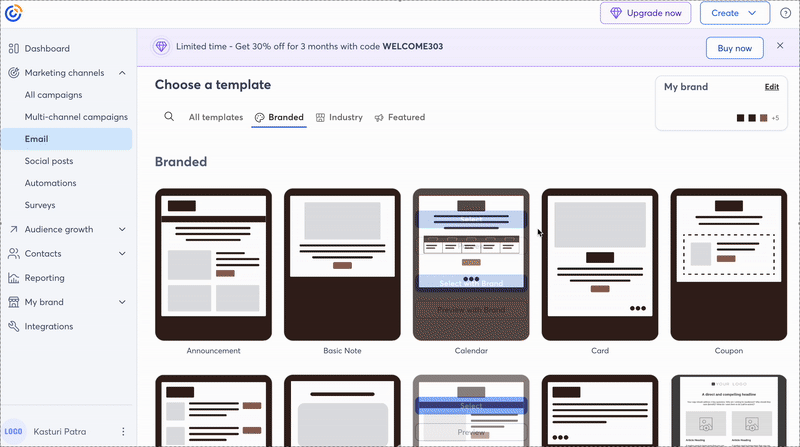
The setup
Domain authentication
Constant Contact automatically verified my email. Great! But if you want to send emails from your own domain, you’ll also need to authenticate it.
Unlike some email tools that handle this automatically, Constant Contact requires you to manually add the provided DNS records to your domain’s settings.
The process might sound technical, but it’s worth doing. Domain authentication significantly improves your email deliverability and reduces the chances of your emails landing in the spam folder.
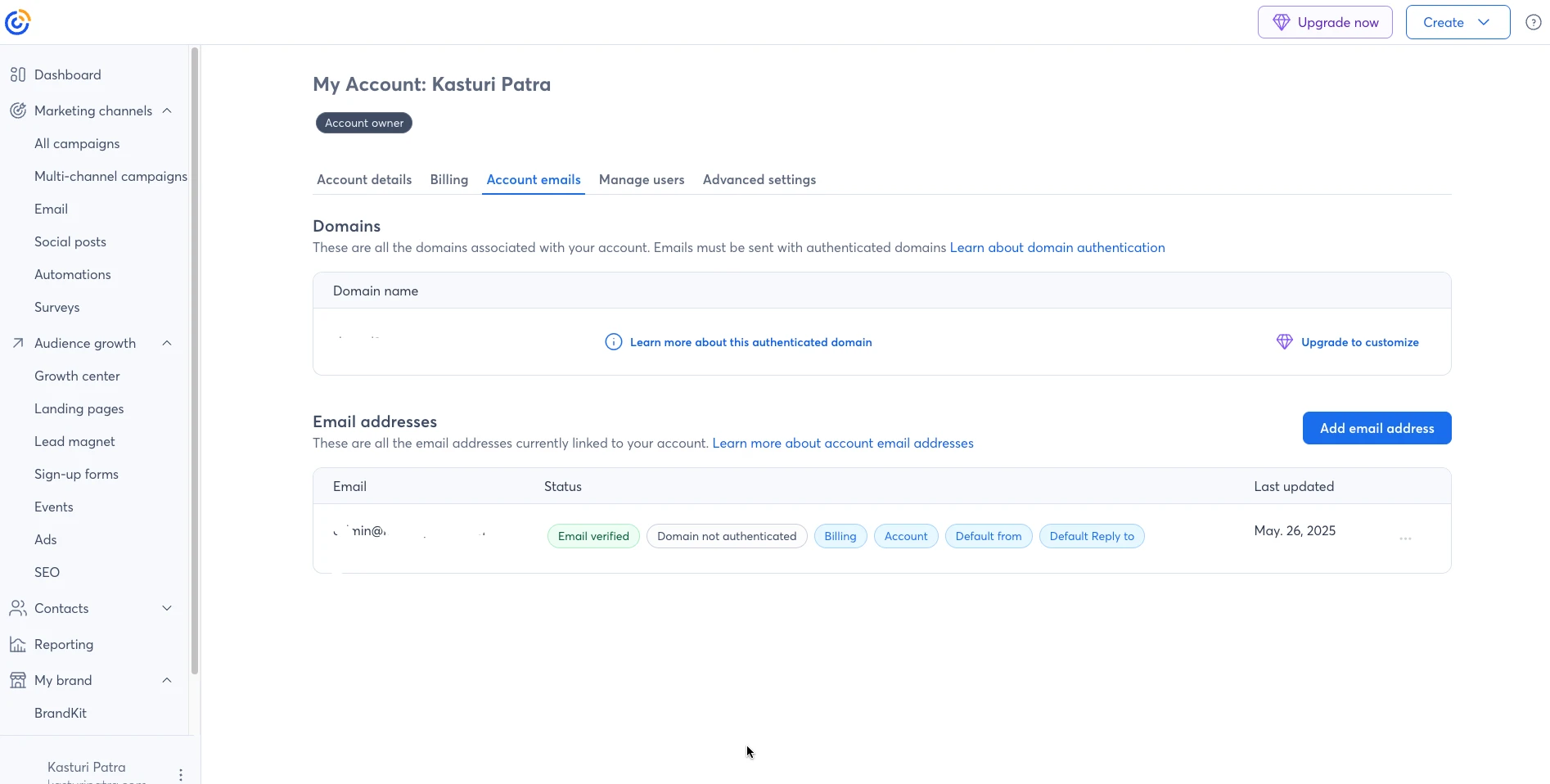
Clear unsubscribe option
The unsubscribe option was clear on my test email, and it also offered an option for people to comment on why they unsubscribed.
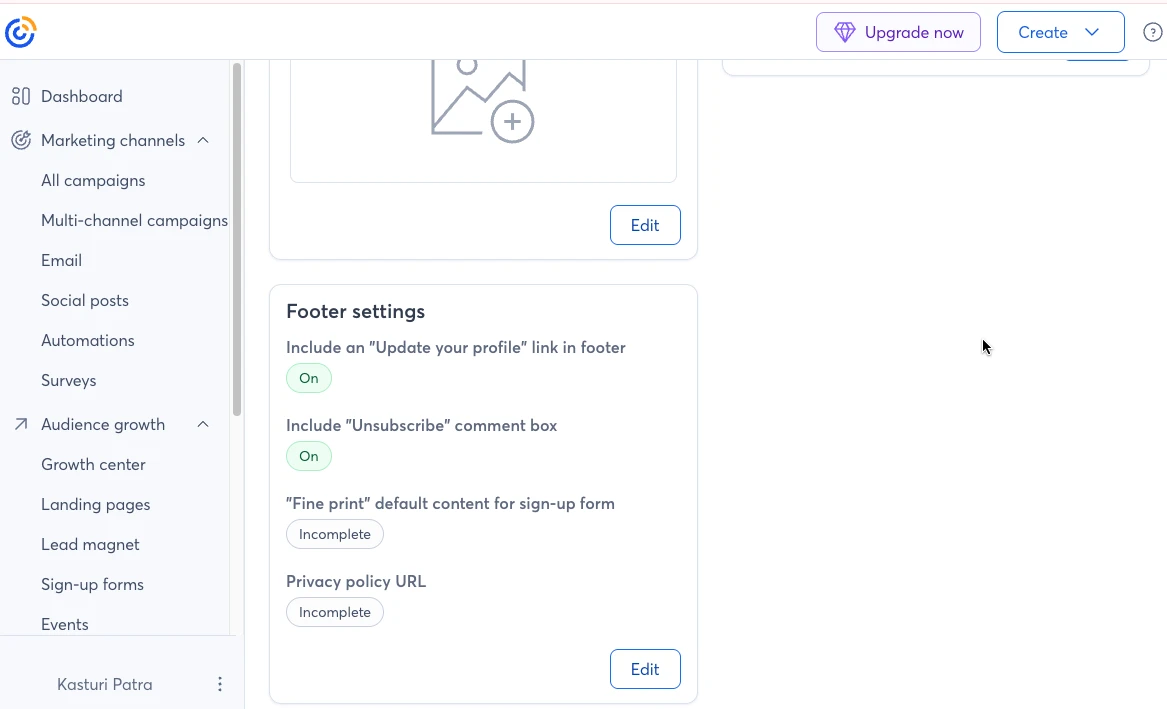
Creating your email marketing campaign
User interface and email creation
Constant Contact's platform interface shines for its ease of use, making email campaign creation straightforward. The drag-and-drop email builder is a breeze to use, offering standard blocks to craft effective emails.
You can easily upload images from your device, phone, social networks, use the ones Constant Contact imported from your brand assets, design images in Canva, or pull stock images from Shutterstock.
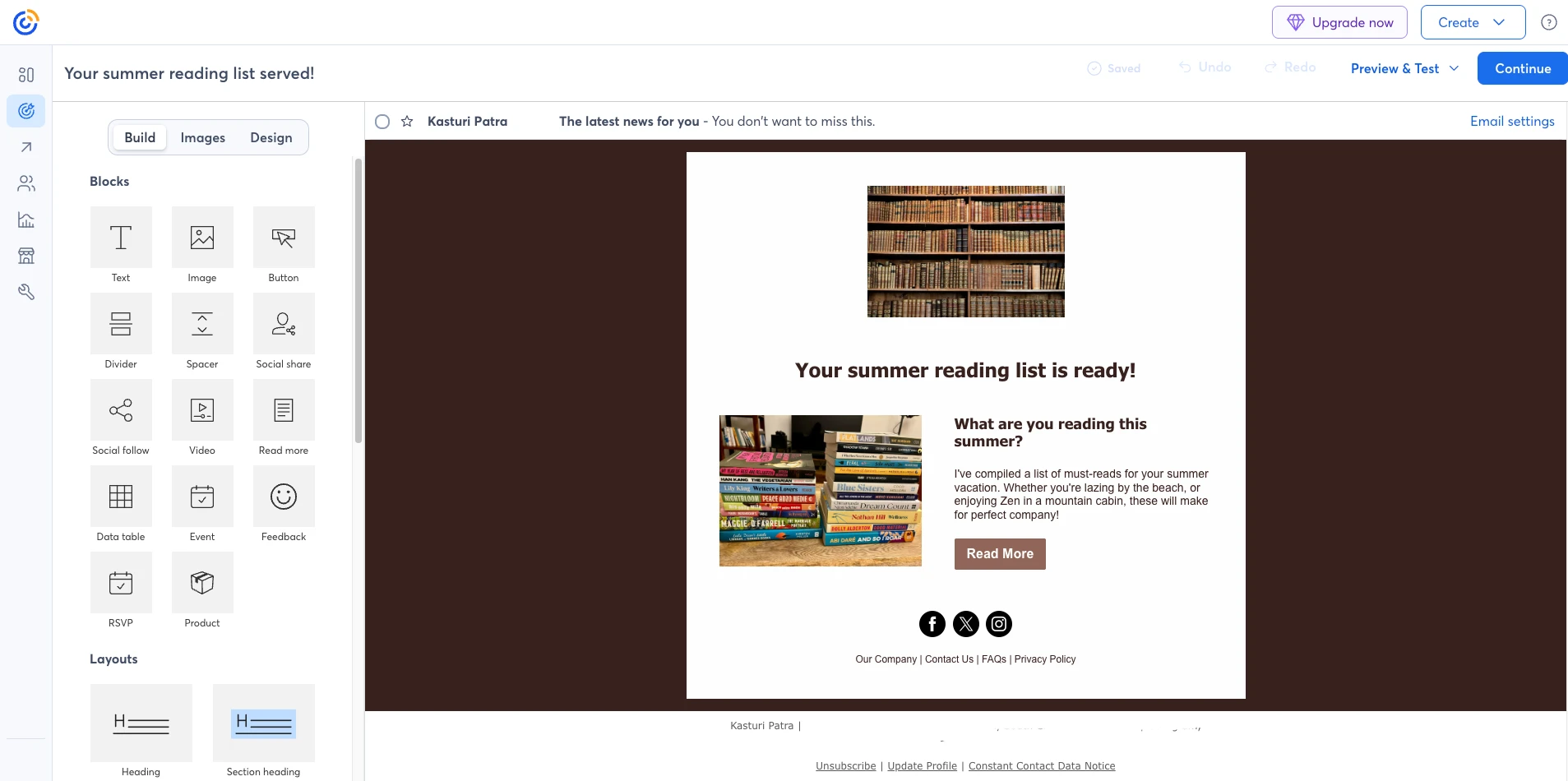
The design tab conveniently displays your imported brand colors, and standard customization options are available to refine your email's look. Sending a test email to preview it in an inbox is straightforward.
While it's a solid tool for basic email creation, some users have reported that the HTML editor can be clunky, which might be an issue if you need more advanced design control.
Here are some key features of the email editor:
Classic drag-and-drop functionality
Customizable templates
Built-in image gallery
Unique event and RSVP integration
200+ email templates (though some of the designs feel dated)
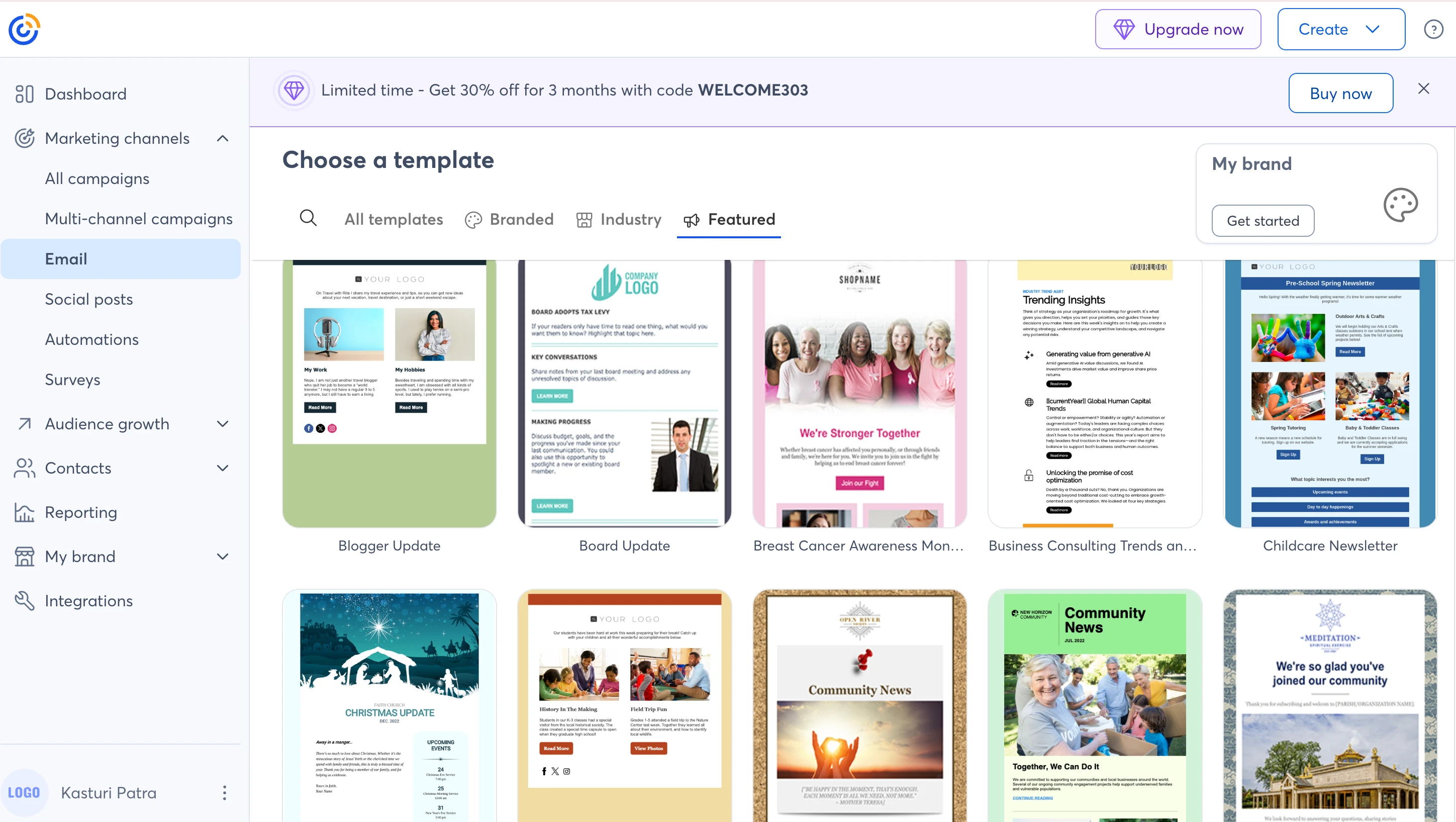
AI assistance
Need a jumpstart on your creativity? Use Constant Contact's AI to generate subject lines and email content. As with most AI, the generated content often requires significant editing, but it's a great starting point for inspiration.
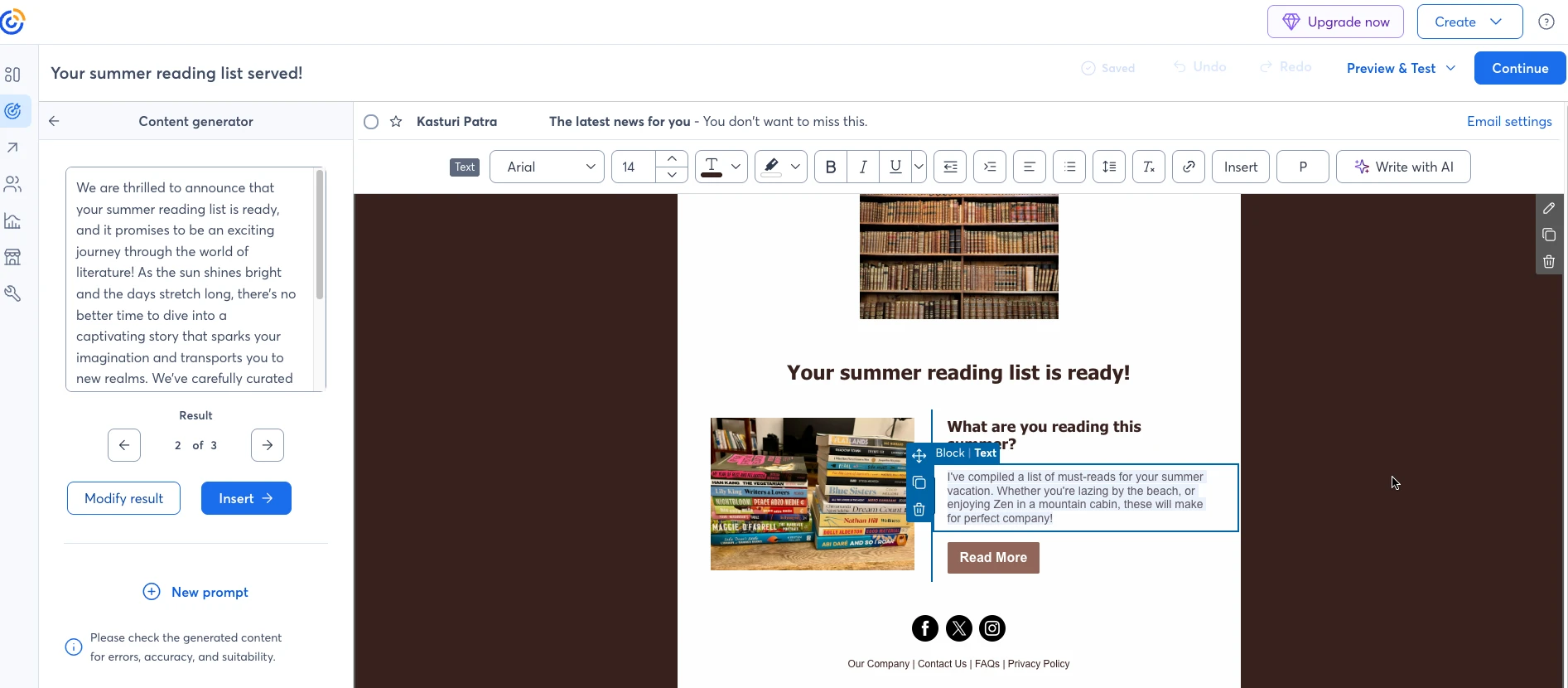
Lead magnets
Constant Contact has a lead magnet generator that lets you quickly create lead magnets based on the questions you’d like to ask your customers. You enter the prompt, your web address, and click on Create.

Next, Constant Contact creates a lead magnet with 6 questions. You have the option to edit the logo, background, questions, and style.
Here’s the lead magnet it created for me with a pre-made background image, logo, and questions:
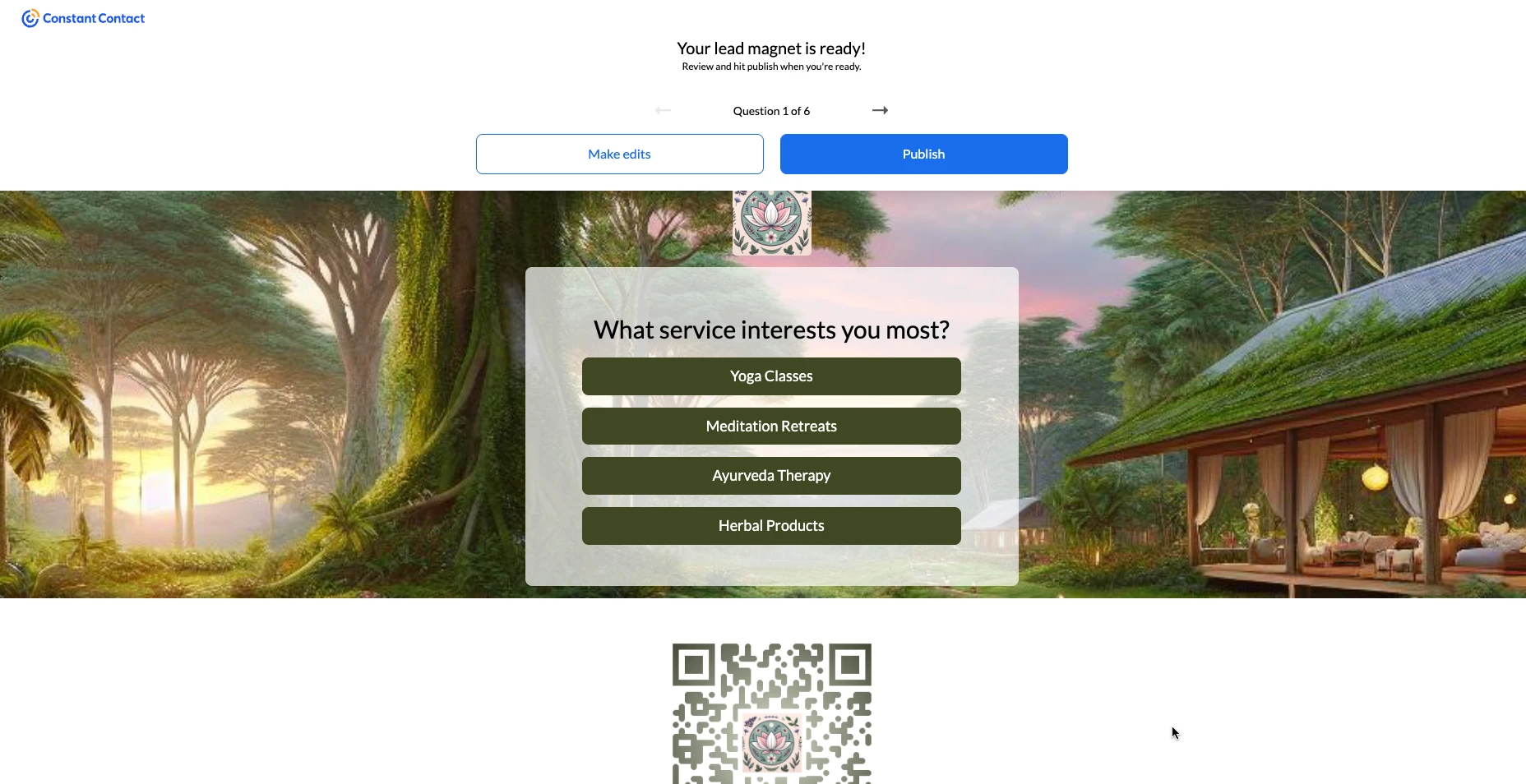
A step-by-step prompt generator is also available to spark ideas, letting you specify customer pain points, target audiences, and products to create tailored lead magnets.
Each lead magnet comes with a short link and a scannable QR code for easy sharing on your website. The share button further extends its reach to social media, email, Reddit, WhatsApp, and Facebook Messenger.
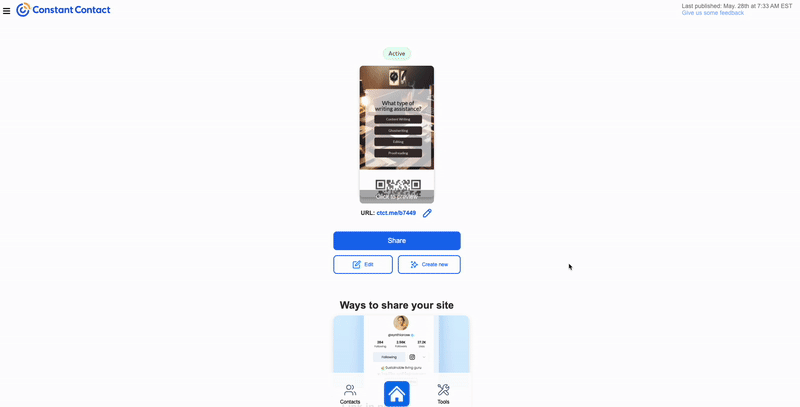
The lead magnet template library has 55 pre-built templates from which you can choose and then further edit.
Forms and pop-ups
Creating forms is straightforward to implement. However, a notable limitation is the fixed order of information collection, which can restrict customization. Pop-up form options are also available.
Landing pages
The landing page feature lets you build a sign-up landing page or customize and make your own landing pages. You can choose from pre-built templates or build one from scratch.

The landing page generator is easy to use with the intuitive drag-and-drop features.
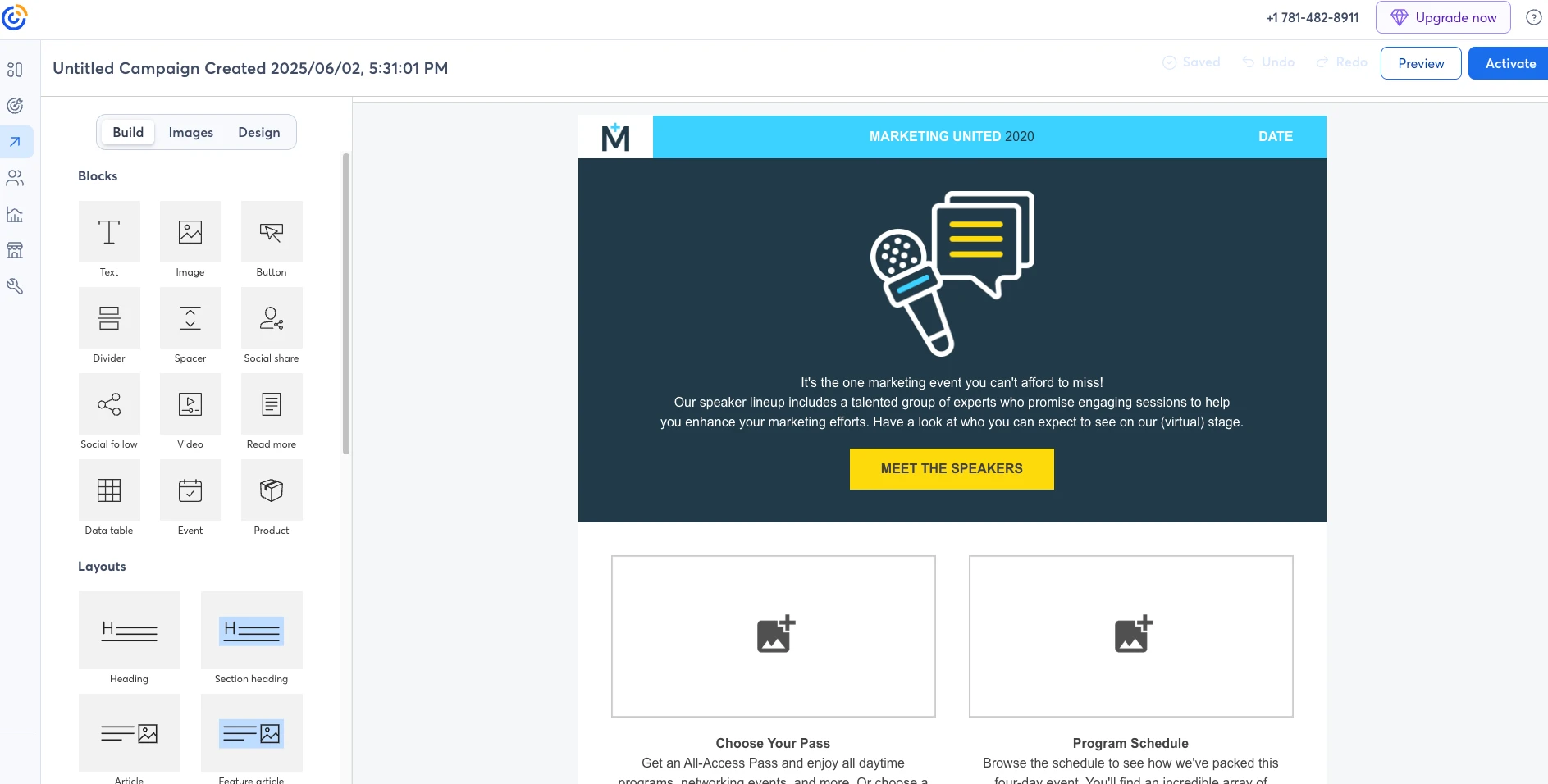
However, it only comes with a limited number of templates. Plus, the template designs look a bit less modern when you stack them up against contemporary designs.
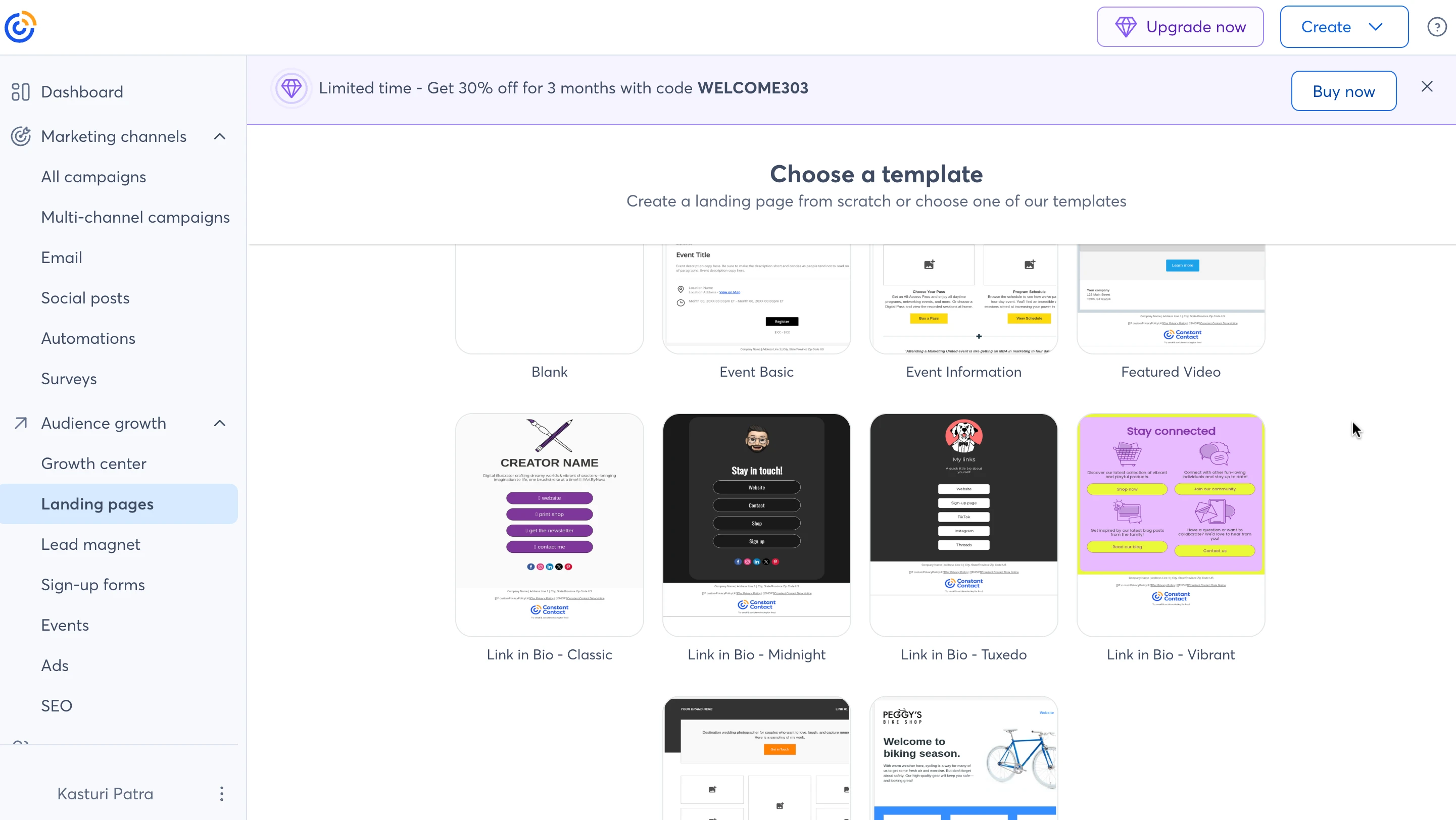
Constant Contact’s landing page and form integration is sufficient for simple lead capture and basic segmentation, but it lacks the advanced customization, conditional logic, and design flexibility found in specialized landing page or form builders. For more sophisticated needs, you’ll need third-party integrations.
Organize events
Another cool feature is Constant Contact's event creation tool. All the familiar drag-and-drop functionalities are here, along with options to add tickets, add-ons, and a default form for collecting names and email addresses (with options to add more fields).
For payments, it supports popular currencies like USD, GBP, and EUR, and accepts payments via Visa, Mastercard, Amex, PayPal, and Venmo, with Stripe and PayPal integrations available.
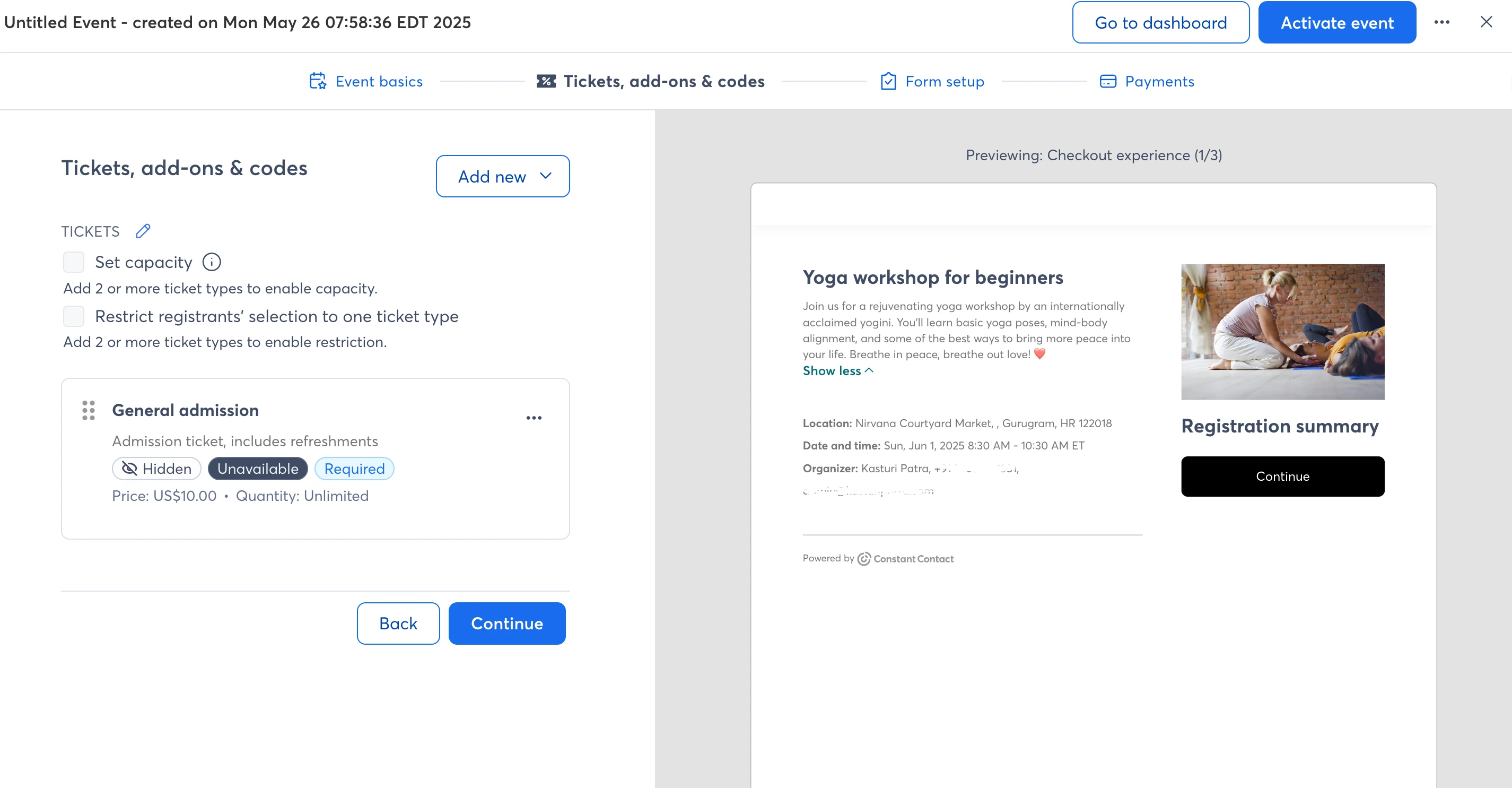
Social campaigns
Constant Contact’s social media integrations are impressive. All you have to do is connect your social media accounts and it’ll take care of the rest.
The social campaign lets you manage and post to multiple social media platforms from a single interface. It’s smooth, efficient, and perfect for social media marketing. You can post instantly or schedule for later if you’re on a Standard or Premium tier.

Surveys
Creating surveys on Constant Contact is easy even for beginners, and here's why: it uses a straightforward drag-and-drop interface, making it simple to add questions and customize the layout. However, the surveys look a bit basic compared to those created by other email marketing tools.
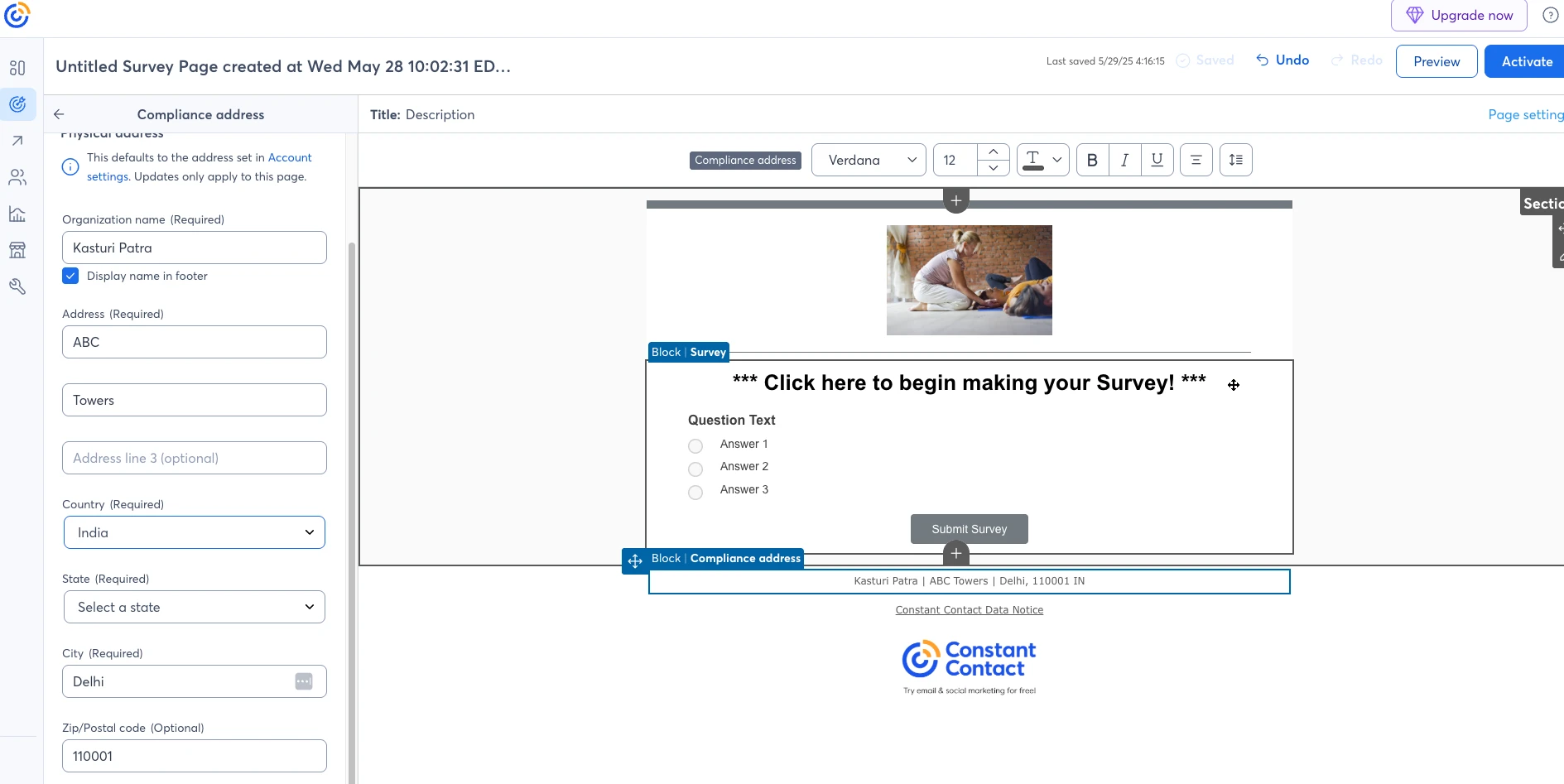
Multichannel campaigns
I loved Constant Contact’s intelligent multichannel campaign planning feature. I asked it to create a weeklong campaign for a new bookstore, including author readings, a café opening, and a 10% discount. Constant Contact automatically generated a comprehensive schedule with specific posting dates and platform recommendations.
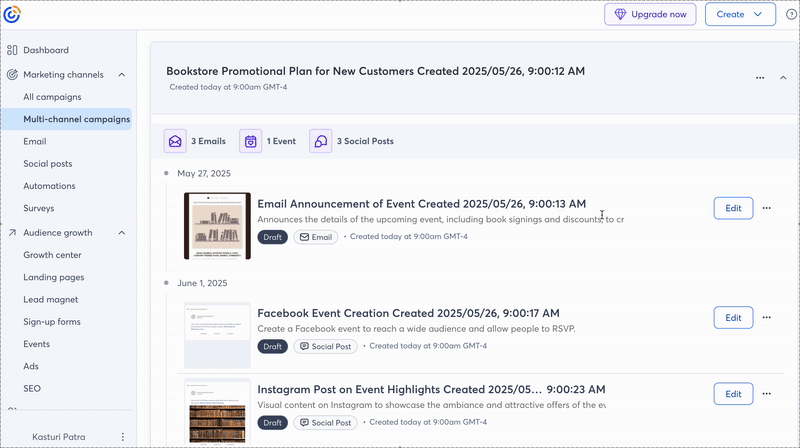
It can even help you create the assets for each step, like the AI-generated announcement email I crafted.
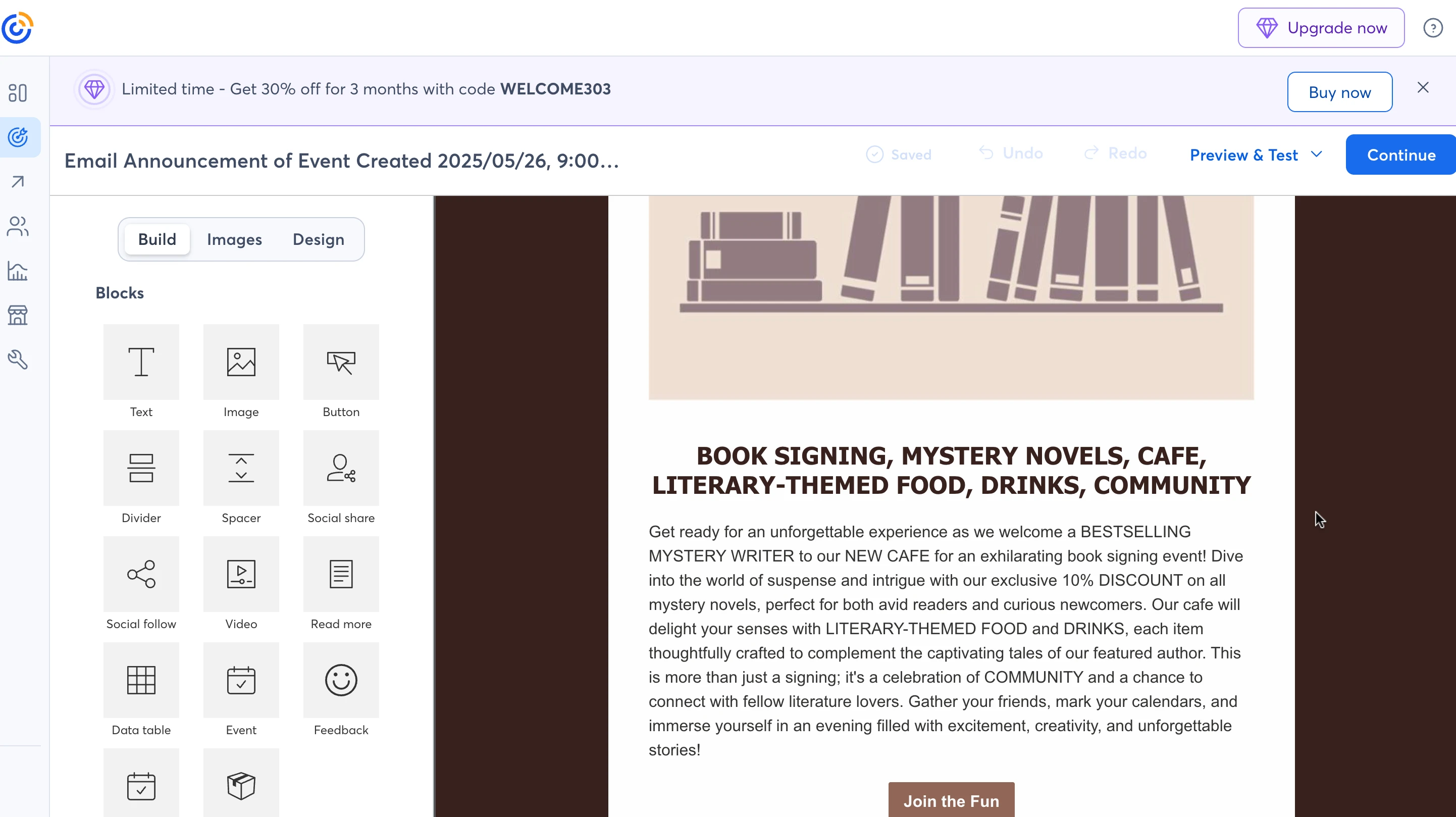
While these features appear robust at first glance, keep in mind that many are tied to pricier tiers.
Sending your email: Segments, automations, and other functions
Segments and groups
Constant Contact lets you organize contacts by creating up to 1,000 lists and adding contacts to multiple lists as needed. For more granular control, the Segmentation Builder lets you filter contacts using various criteria, including:
Contact profiles
Email activities
Engagement
List membership
Shopping activity
Sources and providers
Tags
The tool automatically adds or removes contacts from segments as they meet or no longer meet your defined criteria.
The segmentation options are pretty basic, especially on the Lite plan and Standard plan, where you can create just 1 and 10 contact segments, respectively, and no e-commerce segments.
This means that unless you’re spending money on the Premium plan, you might be restricted if you want to create highly targeted campaigns.

Automations
Constant Contact has plenty of automation features to help you create automated emails. You can start with a premade template and then customize it to your needs. Or you can build the template out from scratch with 12 triggers and then use conditions, delays, emails and actions to build out your sequence.
While it has most bases covered, it is missing some advanced automation features like A/B testing and the ability to use multiple triggers. Plus, e-commerce templates and the ability to create custom automations are only available on the most expensive Premium plan.
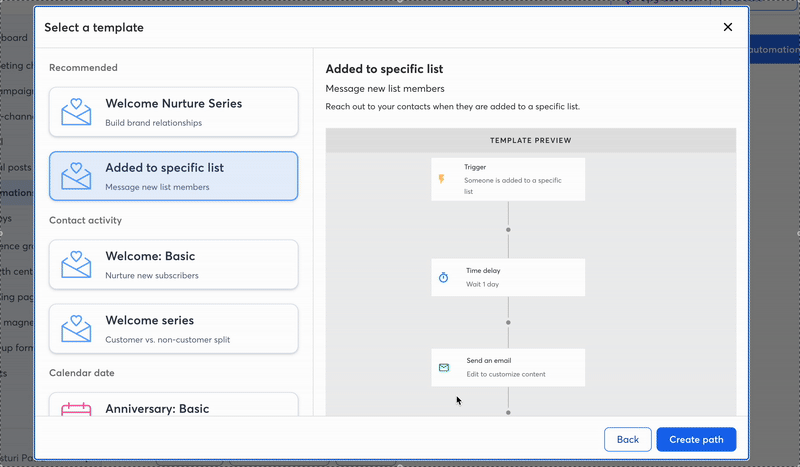
Integrations
Being a long-established email provider, Constant Contact boasts of a massive number of integrations—over 7,800 to be precise. So, it’s easy to connect with all the software and apps you use in your business.
Furthermore, there’s the option to filter the integrations by category like email, e-commerce, CRM, and so on. It also helpfully suggests tailored recommendations based on your needs.
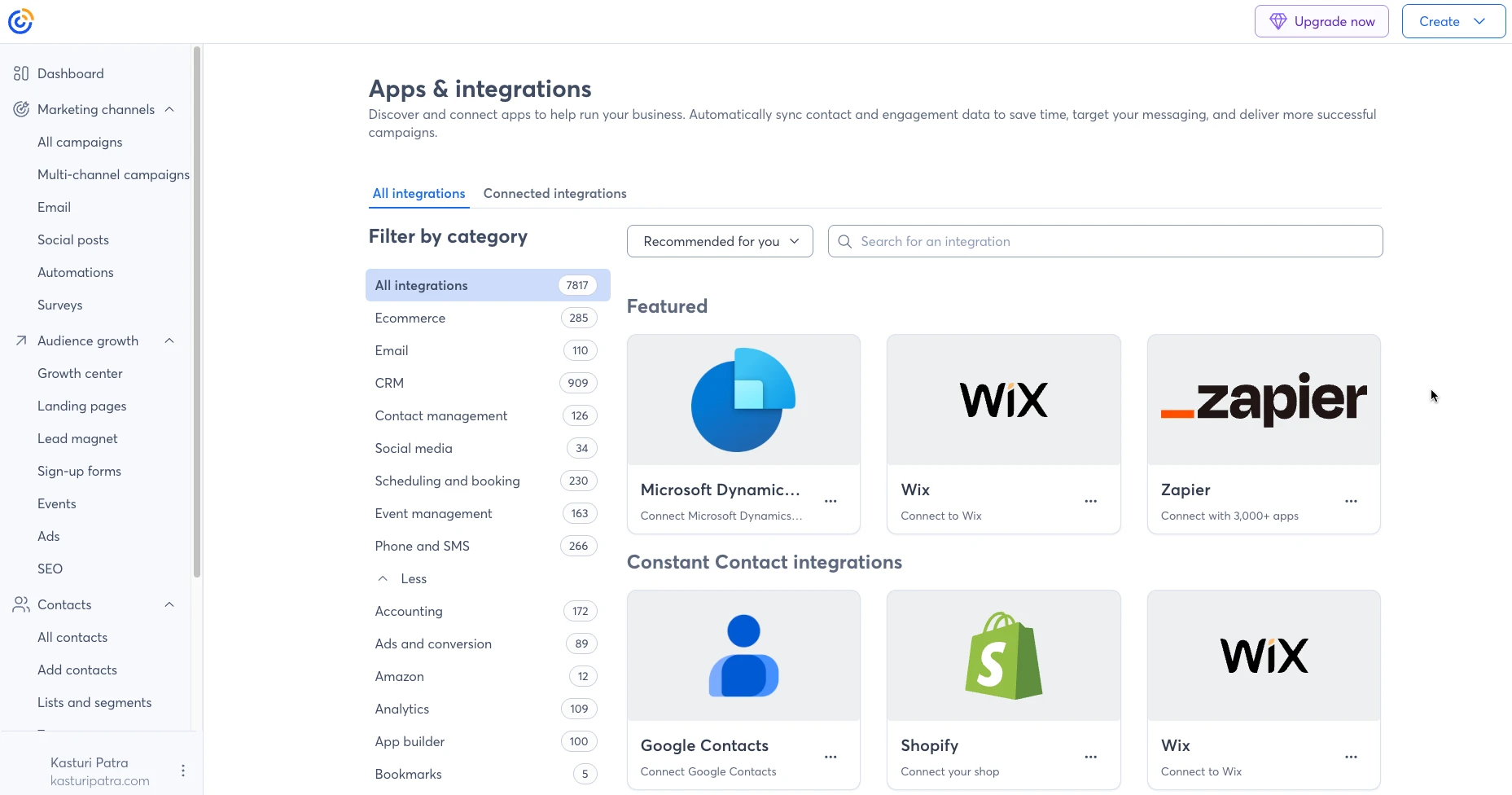
Deliverability
Email deliverability shows the percentage of emails that were delivered to your contacts against the total amount you sent. The higher the deliverability rate of an email marketing software, the more reliable it is, because what’s the point of sending emails if they don’t get delivered?
Email Tool Tester considers anything above 89% an excellent rate, and Constant Contact boasts an impressive 92% deliverability rate, placing it among the top performers. For comparison, ActiveCampaign and MailerLite, in the top 2 positions, have slightly higher rates at 93.4% and 92.7% respectively.
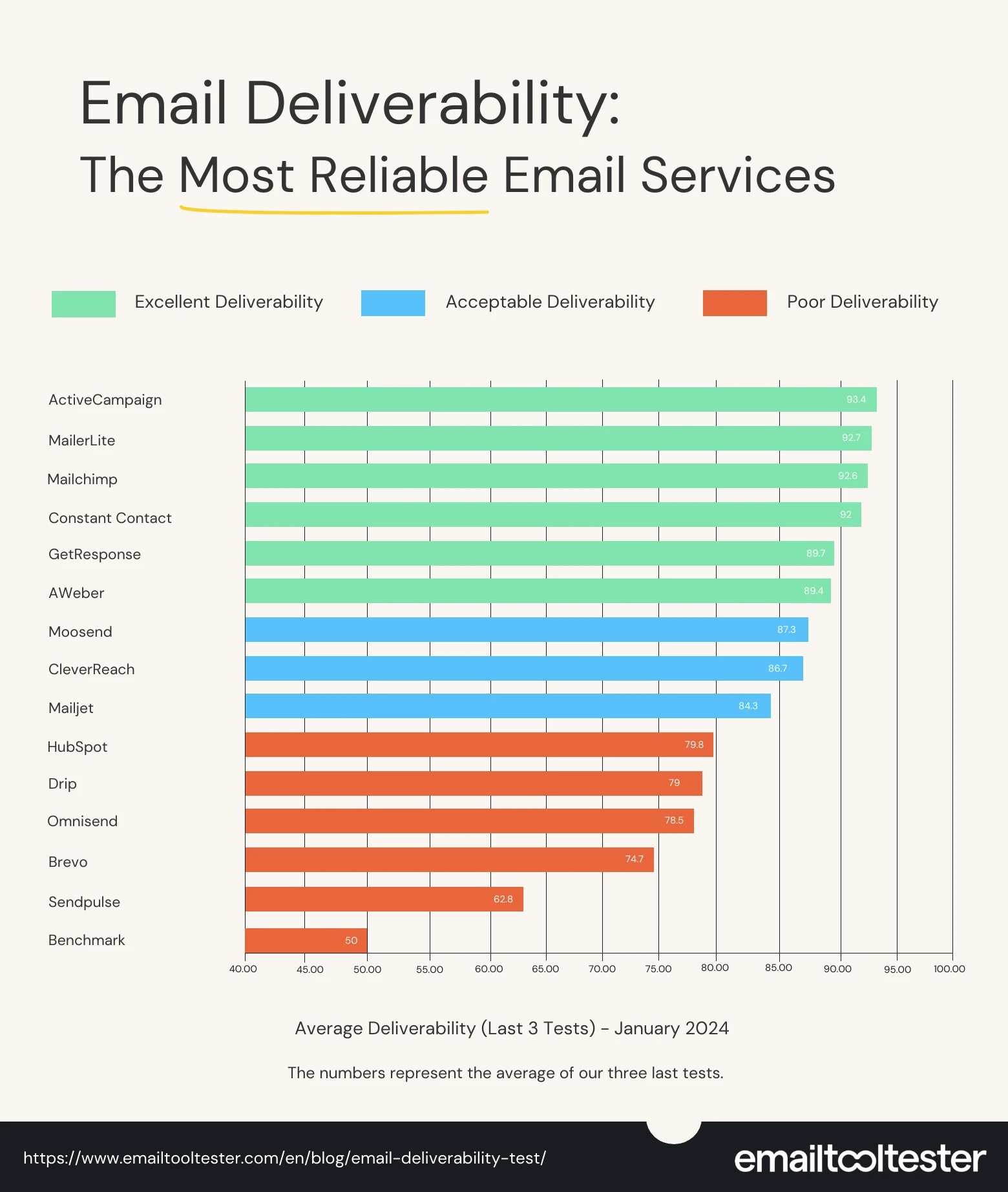
Summary: Pros and cons
| ✅ Pros | ❌ Cons |
|---|---|
| Excellent user-friendly interface | Expensive pricing structure |
| Comprehensive feature set (for basics) | Limited automation capabilities on lower tiers |
| Strong multichannel campaign capabilities | Dated template designs |
| Automated brand color integration | Basic segmentation options on lower tiers |
| Event management features | No mobile app |
| Excellent deliverability | Limited A/B testing capabilities |
| A huge set of integrations |
How MailerLite goes further: Advanced features at an affordable price tag
Constant Contact covers the basics, but if you want email marketing campaigns that drive results, then MailerLite gives you the advanced tools without the premium price tag.
MailerLite packs all the latest email marketing features, helping you craft professional emails, build stronger relationships, and truly grow your business.
Let’s take a look at some of the features that make MailerLite stand out:
Advanced drag-and-drop editor that doesn't box you in
MailerLite's editor gives you true creative freedom. You get multiple builder options: the intuitive drag-and-drop, rich-text, and even custom HTML for when you need to get technical. You can embed social media posts directly into emails and create modern, responsive designs that impress subscribers.
Dynamic content that speaks to each subscriber
MailerLite’s handy targeting options, like email segmentation and groups, let you send emails to specific audiences.
Dynamic email content takes this a step further, allowing you to add blocks to your email that are only visible to a particular audience, dramatically increasing campaign relevancy for each subscriber group.
This is where MailerLite truly shines for personalization. You can create one email that shows different content to different subscribers based on their preferences, behavior, or tags. This level of personalization would require setting up multiple, separate campaigns if you use Constant Contact, but MailerLite handles it seamlessly.
Landing pages that convert
MailerLite provides fully customizable landing page templates that integrate effortlessly with your forms and overall email marketing strategy.
And the best part? You can create 10 landing pages in the free option and unlimited in the paid tiers. You can choose from 26 templates or build one from scratch to match your brand perfectly.
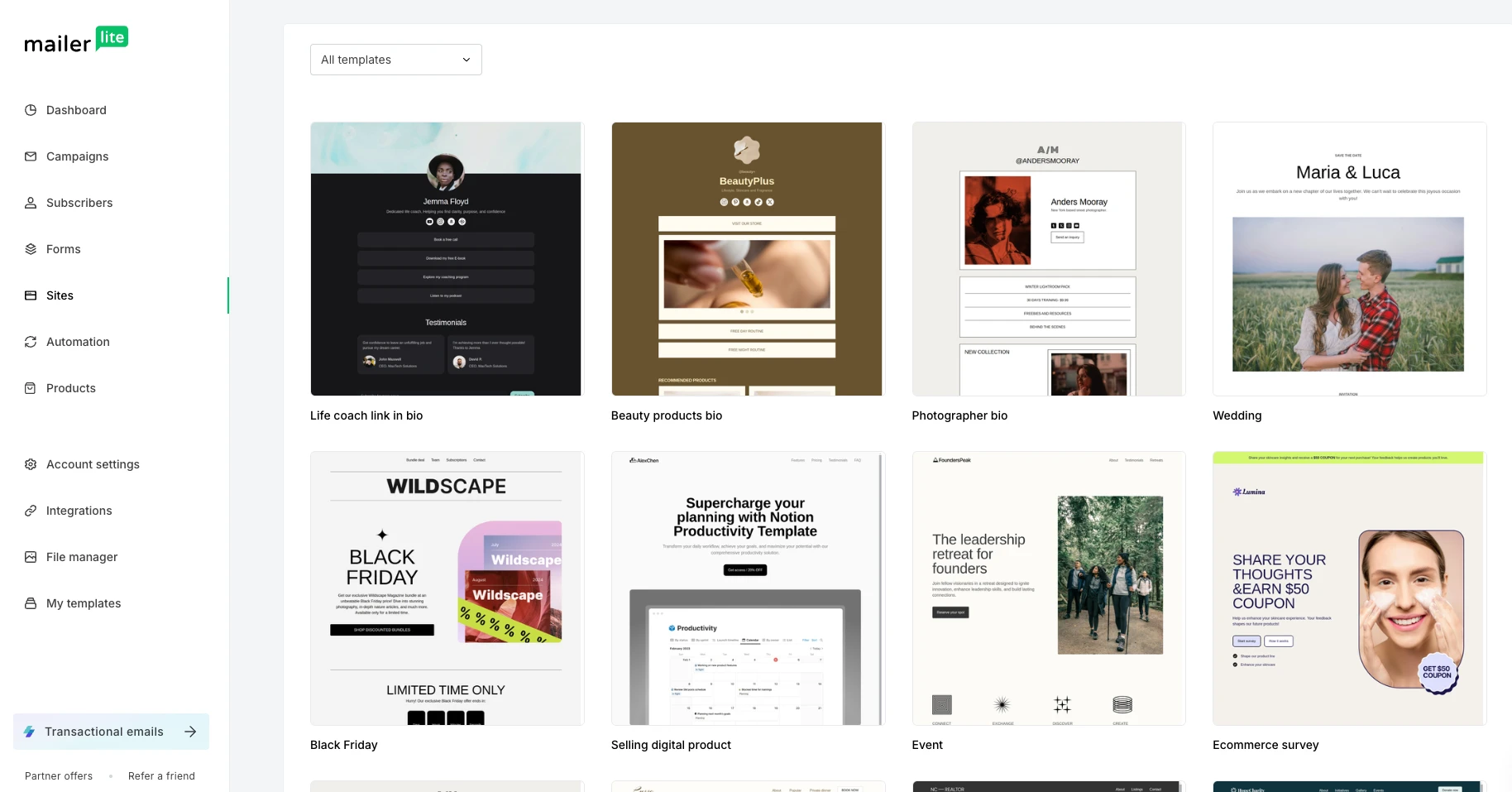
Powerful signup forms
With MailerLite, creating embedded forms for your website or web pages is really easy. These forms seamlessly collect new subscribers and can even automatically segment them based on their inputs.
You get tons of design flexibility, from background to content style to CTA, and can even customize with HTML and CSS if you're feeling fancy.
Behavior-based pop-ups are super easy to create, triggered by timing or scrolling. Start from scratch and use 11 different kinds of blocks, including videos, countdown timers and even custom code to create pop-ups that match your exact needs.
Or pick from 23 pre-designed options, including email opt-ins, newsletter sign-ups, and even a "spin the wheel". Add your branding in seconds with our brand styles feature, then adjust the design further with our customization tools.
You can even add a teaser that stays on the web page before and after the pop-up appears to maximize its visibility.
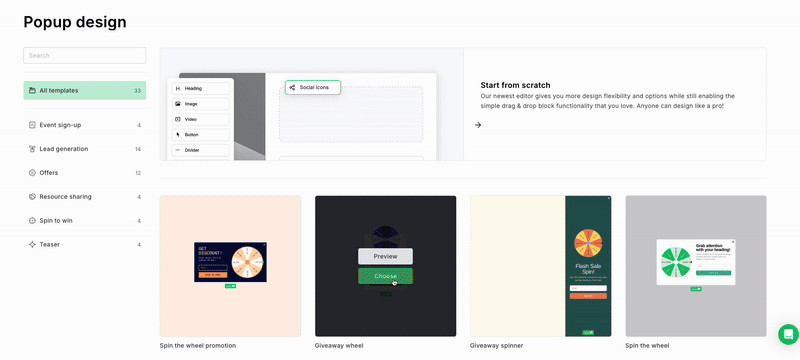
Here’s a pop-up form I created with MailerLite.
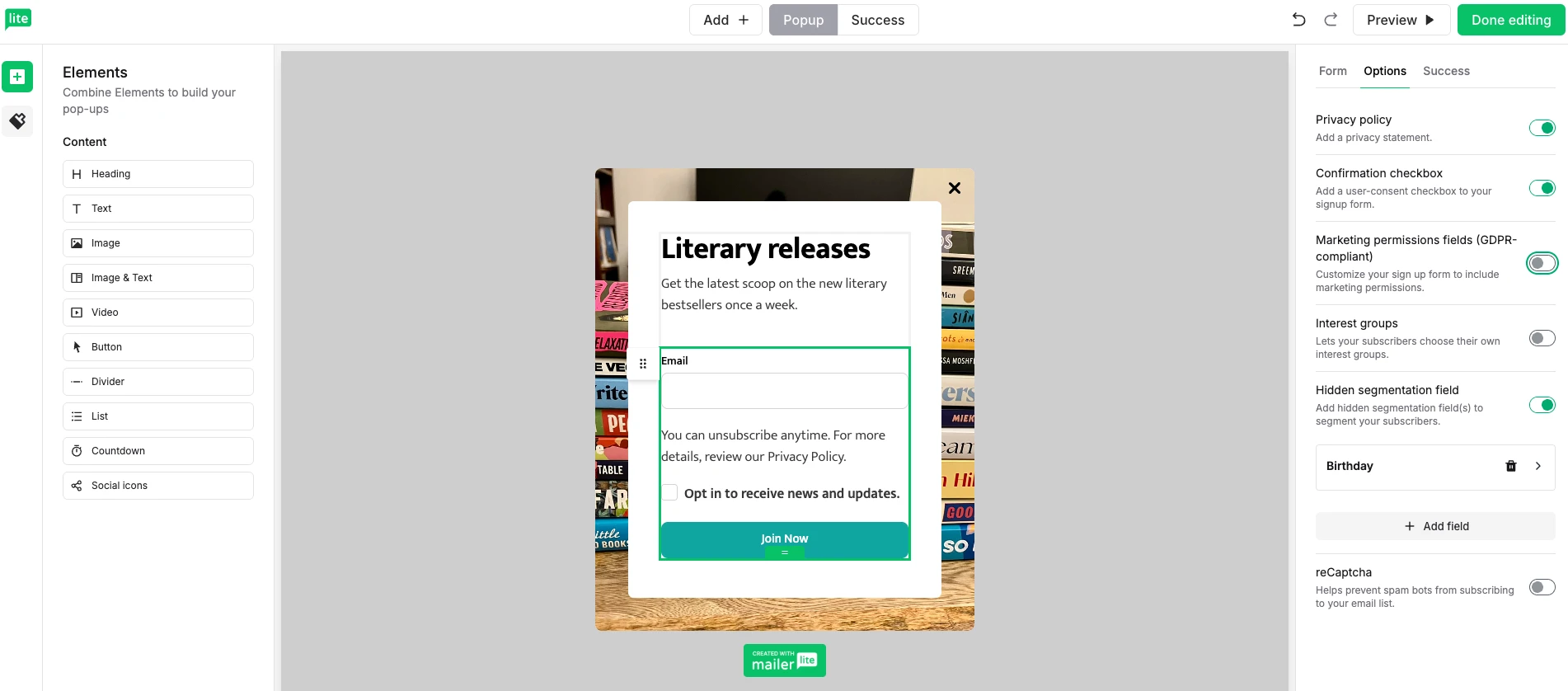
Surveys: Listen to your audience and learn
Want to know what your audience thinks? MailerLite's survey feature makes it simple to ask questions and get valuable feedback directly from your subscribers. You can create various types of surveys, from quick polls to more detailed questionnaires.
This is a fantastic way to understand your audience's preferences, gather ideas for new products, or improve your content, all within your email marketing platform.
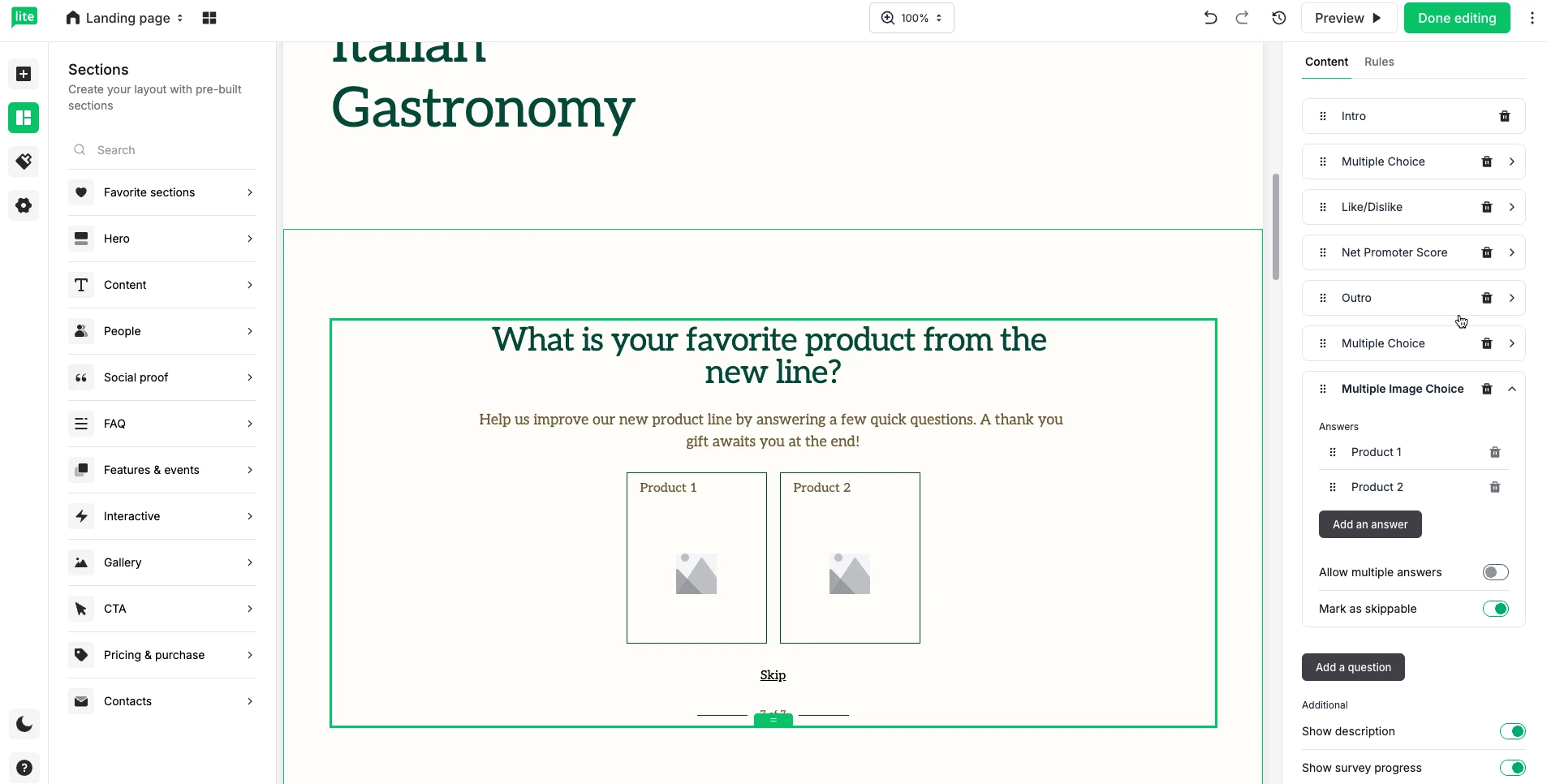
As you can see from the preview, the surveys created with MailerLite look contemporary and sleek.
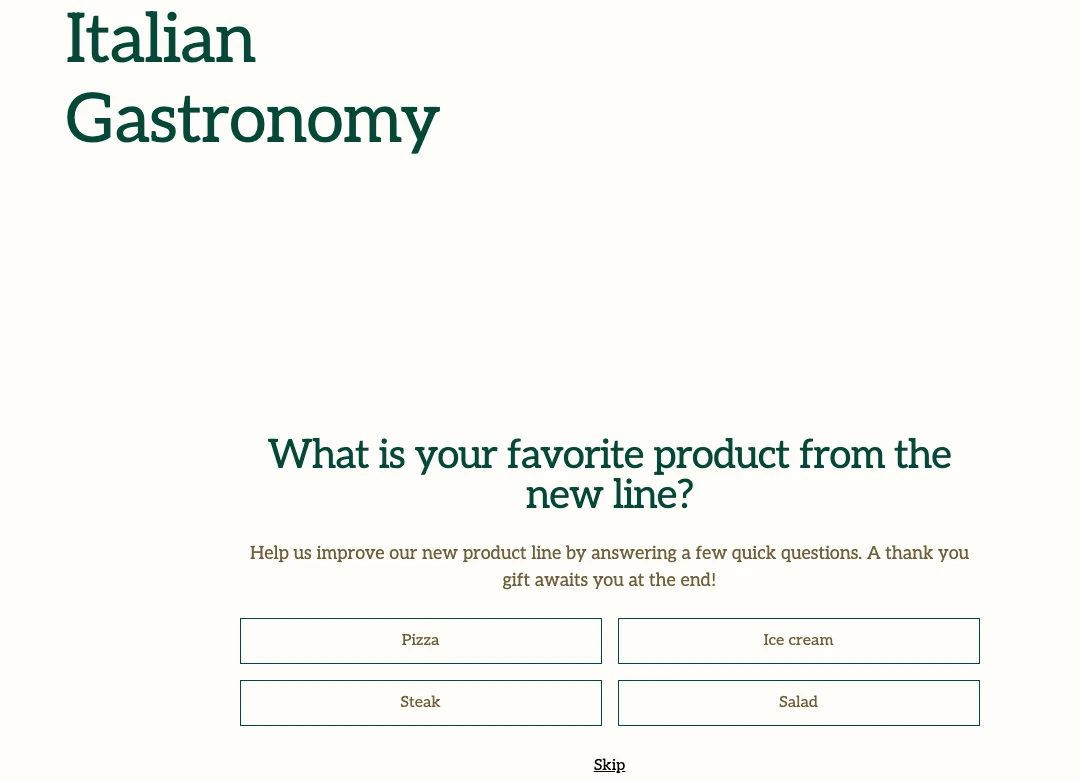
Advanced AI tools to help you work smarter
MailerLite’s AI email marketing features help you save time and improve your campaign results.
Spark your creativity by generating email content, subject lines, landing pages and images in seconds with built-in features you can access from within the relevant builder. Just hit the AI suggestions button in any text field and tell the tool what you need.
You can also connect your MailerLite email marketing data with AI tools like ChatGPT using our MCP server to get a personalized analysis of what works in your campaigns and then take steps to improve them.
For example, once set up, you could ask ChatGPT—using natural language as with any other prompt—to analyze your best-performing campaigns and then make suggestions for future newsletter topics that people are likely to enjoy.
Or you could ask it to break down the performance of your latest campaign or automation and provide suggestions for how to improve next time.
The best thing is that MailerLite’s MCP server is hosted by us, meaning you can set it up in minutes as long as you have a supported plan, such as a paid plan on Claude or ChatGPT. Check out this article on using MCP servers in email marketing for more actionable suggestions on how to use it.
More powerful email sending options
Smart sending: AI-powered optimal delivery
MailerLite's smart sending is powered by AI and machine learning. This intelligent tool analyzes your past campaign data and individual subscriber behavior to pinpoint the exact moment each person is most likely to open your email.
Smart Sending optimizes delivery times for each subscriber instead of mass-sending at a fixed time. This personalized approach dramatically boosts open rates and engagement, leading to more clicks, conversions, and ultimately, higher revenue.
Send by timezone: Timely delivery, globally
For those critical emails where timing matters across different regions, MailerLite's send by timezone feature is invaluable. Set a single desired delivery time (say, 9 AM), and your email will automatically arrive in each subscriber's inbox at that exact local time, regardless of their location.
Auto resend
MailerLite's auto resend feature lets you retarget subscribers who didn't open your initial email. You can potentially reach 30% more subscribers by automatically resending an email. You have the option to resend with a different subject line or even slightly tweaked content.
Sophisticated automation options
If you're looking for advanced email automations, MailerLite is where you should go. Constant Contact restricts you to primarily single-trigger automations and basic templates, often locking advanced workflows behind its most expensive plan.
MailerLite boasts an intuitive visual workflow builder that we recently revamped to make creating more powerful automations easier than ever.
We introduced a true drag-and-drop interface, as well as new triggers, tools and UI elements so you can create and reorder multi-step automation journeys with ease. Think multiple triggers, branching logic (the all-important if-then conditions), and time delays. This gives you granular control over the entire subscriber experience.
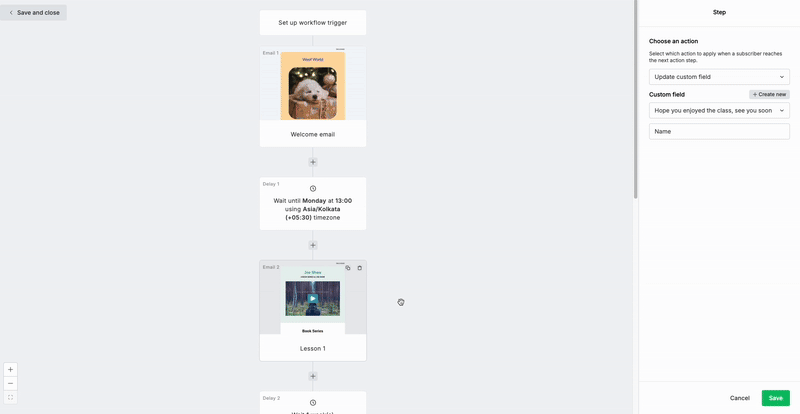
Advanced triggers and actions for deeper personalization
MailerLite goes beyond basic actions like sending emails or updating tags. Its sophisticated automation triggers are based on a wide array of subscriber behaviors, including form fills, e-commerce events (abandoned cart, hello!), email link clicks (which can segment or initiate new workflows), and form submissions.
This versatility allows you to create:
Comprehensive welcome series
Lead nurturing funnels
Customer onboarding sequences
Event-based reminders and follow-ups (for webinars or events)
Automated re-engagement campaigns
And the best part? MailerLite provides these powerful automation features, including its visual builder and a wide range of triggers, across its paid plans.
A/B Testing within automations
While Constant Contact's A/B testing limits you to subject lines, MailerLite lets you test subject lines, email content, automation workflows, pop-ups, and landing pages. Plus, multivariate testing lets you test multiple factors at once.
This data-driven approach helps you continuously improve your automated campaigns, giving you invaluable insights into what your subscribers truly want.
Selling digital products
MailerLite lets you easily sell digital products directly from your account, turning your creative ideas into revenue.
Whether it's an e-book, a template, or a digital art file, you can set up a simple storefront, upload your products, and handle payments. It's a straightforward way to monetize your expertise or creations without needing a complex e-commerce setup, making it accessible for creators and small businesses.
Plus, we don’t charge any commission. This means selling digital products is not only easier with MailerLite, but you also get to keep all your revenue, other than a small payment processing fee from Stripe.
Analysis that drives action
Forget drowning in overwhelming data. MailerLite provides clear, actionable insights with its intuitive reports. You can easily track opens, clicks, and engagement, helping you truly understand what's working and why.
Integration ecosystem that plays well with others
With MailerLite integrations, connect with over 130 popular tools and platforms, from Shopify to WordPress. Need something custom? The robust API lets you build exactly what you need.
Pricing
A free plan that actually delivers
While Constant Contact makes you pay from day one after your free trial, MailerLite offers a useful free plan that isn't just a teaser. It supports up to 500 subscribers and up to 12,000 monthly emails.
The free tier includes the drag-and-drop editor, email automation builder, 1 website, 10 landing pages, unlimited signup forms and pop-ups, some automation templates, e-commerce integrations, A/B testing, surveys, quizzes, and deliver emails by timezone.
Plus, you get premium reporting features like comparative reporting, list growth, and e-commerce sales tracking. These are features Constant Contact often locks behind higher tiers or doesn't offer at all for its starting $12/month Lite plan.
For just $10 a month (with a 10% annual discount) for up to 500 subscribers, MailerLite's lowest paid tier adds selling digital products, unlimited templates, dynamic emails, campaign auto-resend, multivariate testing, unlimited websites, blogs, landing pages, and more.
Here’s a website I created with MailerLite:
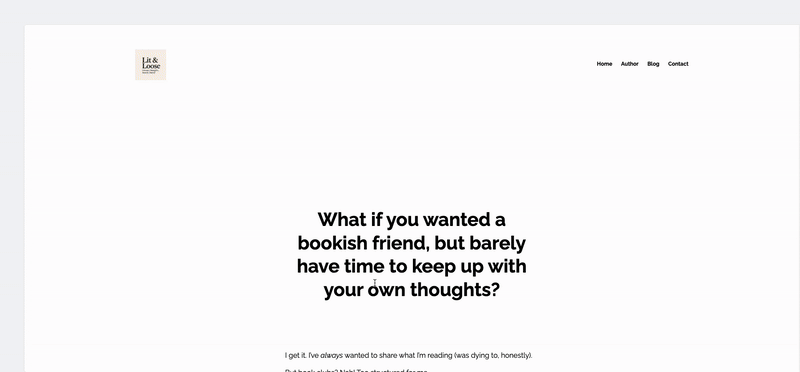
Let’s compare the prices for MailerLite and Constant Contact for up to 500, 10,000, and 50,000 subscribers.
The table below shows MailerLite's pricing plans:
| No. of subscribers | Growing Business lan | Advanced plan |
|---|---|---|
| Up to 500 subscribers | $10/month | $20/month |
| Up to 10,000 subscribers | $73/month | $110/month |
| Up to 50,000 subscribers | $289/month | $340/month |
There’s a 10% annual discount and a 30% discount for non-profit organizations.
Now, let's check out Constant Contact's pricing:
| No. of subscribers | Lite plan | Standard plan | Premium plan |
|---|---|---|---|
| Up to 500 subscribers | $12/month | $35/month | $80/month |
| Up to 10,000 subscribers | $120/month | $160/month | $275/month |
| Up to 50,000 subscribers | $430/month | $460/month | $575/month |
As you can see, the more you scale your small business, the more expensive it gets to have an account with Constant Contact. Even the Lite plan at 10,000 and 50,000 subscribers is more expensive than the highest tiers of MailerLite.
Plus, Constant Contact imposes overage fees for exceeding sending limits. There are no such hidden costs with MailerLite.
Constant Contact or MailerLite? You decide!
MailerLite gives you email marketing freedom. Whether you're just starting out as a small business or scaling up, with MailerLite, you get professional-grade email marketing tools without the enterprise-level price tag.
Here are some of the awards that MailerLite got from G2, GetApp, TrustRadius, and Email Tool Tester recently.

Want to see MailerLite’s features in action?
Start with MailerLite's free plan and experience the difference yourself.
